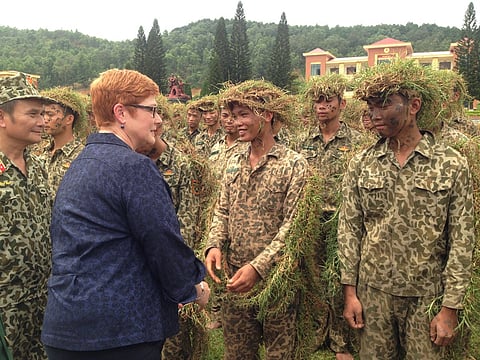

When then Prime Minister Paul Keating visited Vietnam in 1994 – a year before Vietnam normalised relations with the US and joined ASEAN – he came home convinced that this Southeast Asian nation would gain strategic weight.
Today with a highly motivated, entrepreneurial, outward-looking population of some 94 million, Vietnam is emerging as a key regional actor and an important partner for Australia. Recognising this, Canberra will sign a strategic partnership agreement this week when Prime Minister Nguyen Xuan Phuc attends the Australia–ASEAN Special Summit.
Vietnam's recent ties with the US, Japan and India present a positive development for Canberra too. The historic visit to Danang by the American aircraft carrier, the USS Carl Vinson, can be seen as a symbol of important change. The same week, President Tran Dai Quang paid a state visit to India – with whom Vietnam has the highest level of comprehensive strategic partnership, alongside China and Russia – to advance and consolidate cooperation.
Late last year, Hanoi upgraded its relations with Tokyo to extensive strategic partnership, and with the US to enhanced comprehensive partnership. Hanoi's active engagement with these four powers is not accidental. Of all Southeast Asian countries, Vietnam is potentially the most eager to see concrete results from the Quadrilateral Security Dialogue. Its commitment to maintaining maritime security makes it a vital partner for those who also pledge to ensure that the Indo-Pacific remains free and open.
Trusted partners
Nearly 45 years after the last Australian troops left Vietnam, the two countries have every reason to be trusted partners. Canberra established normal diplomatic relations in 1973 with the then North Vietnam. The first formal strategic dialogue between Hanoi and Canberra took place in 1998 and the relationship received a boost after the China moved its oil rig HYSY-981 into Vietnamese waters in 2014.
Australia became a major destination for Vietnamese refugees in the 1970s and 80s and now has the second-largest Vietnamese population outside of Vietnam. In 2016 some294,798 people living in Australia claimed Vietnamese ancestry.
Vietnam has the third-largest population in Southeast Asia – it's expected to reach 100 million in 2025. It ranks first in terms of middle-class growth, and second in terms of urban population growth.
Vietnam's strategic position isn't only important because of its position on the South China Sea, but also because of the access it provides to the Greater Mekong Subregion, which serves as a land bridge connecting the markets of China, Southeast Asia and South Asia.
Vietnam is Australia's fastest growing trade partner in the ASEAN region. Exports to Vietnam have grown by 16 per cent annually for the past decade. It grew from US$32.3 million in 1990 to US$6 billion in 2017. But Australian foreign direct investment in Vietnam, which totalled US$1.65 billion in 2017, hasn't made it to the top ten investors' list.
Vietnam's ambitious, increasingly highly educated workforce and entrepreneurial society present opportunities for many Australian sectors to increase their investments, particularly in energy, education and agricultural. Both Vietnam and Australia are committed to making the proposed Trans-Pacific Partnership happen.
The strategic partnership with Vietnam is an early and concrete realisation of the goals in the 2017 foreign policy white paper released late last year in which Canberra committed to paying more attention to Southeast Asia. The white paper described Vietnam as a partner that's increasingly prosperous, outwardly focused, stable and resilient.
In 2015, then Prime Minister Nguyen Tan Dung visited Canberra to enhance the comprehensive partnership. The decision to elevate it to a strategic partnership wasannounced during the APEC summit held in Danang in November last year.
A stable and peaceful region
But this strategic partnership is more than just an outcome of favourable conditions. It needs strategic constellations to align. Indeed, it reflects the two countries' recognition of mutual strategic importance, as well as a sense of growing need for cooperation.
Australia and Vietnam share not only a vision of a stable and peaceful region, but also a commitment to guard stability and peace through support for the rules-based order and for multilateral institutions.
Australia has welcomed Vietnam's more active role in multilateral frameworks, both regional and global. Hanoi's contribution to UN peacekeeping forces has been well received in Canberra. Last August, during her visit in the region, Defence Minister Marise Payne offered assistance and training for peacekeeping personnel. She also indicated support for Hanoi's bid for re-election as a non-permanent member of the UN Security Council for 2020–21.
There are fundamental differences in Australia's and Vietnam's political systems. Those complicated progress towards closer cooperation for a long time. However, the Australia–Vietnam strategic partnership proves that security cooperation is possible despite political differences when actors are responsible stakeholders upholding international law.
This week's signing of the strategic partnership brings important diplomatic reassurance. It opens the way for Australia and Vietnam to work more closely in key areas of common interests, particularly in the maritime domain. The two countries have increasingly convergent regional security outlooks. They're also complementary in many aspects. Australia's naval capability can provide training opportunities to Hanoi, while Vietnam can offer advice based on its long experience in coping with China.
